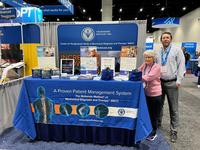News Room
How to Build a PT Practice in 15 Minutes
Lynn Grimm works for free … and her practice has never been stronger.
That’s because the 15 minutes she invests in free consultation with potential patients almost always leads to return visits. In fact, these discovery sessions, along with impressed patients, are the primary support for her cash-based business.
The formula is a simple one. Grimm, PT, Dip. MDT, introduces herself, explains her process and then gives an estimate of how many visits it should take to solve the problem.
This initial consultation is actually done using the same intake forms she would use with any new patient – a patient information and consent to treat, medical history, as well as image release. Grimm is able to get a solid history and even gives a quick posture, neuro and movement loss exam. Then she simply pauses the process and gives the option to continue.
Most do, sometimes on the same day if her schedule allows. If she suspects sinister pathology, she recommends immediate appropriate referral.
“I think it’s really important because it starts to develop the therapeutic alliance,” she says. “You can see if it’s going to be a good fit and in the system of care that I use, MDT, that’s especially important.
"Because it’s all based on the goal of self-care – ultimately the patient is going to be responsible for themselves, their treatment and recovery plan,” Grimm says.
She gives full credit to the McKenzie Method® of Mechanical Diagnosis and Therapy® (MDT) and its unique assessment and intervention that accurately and quickly address musculoskeletal issues.
The MDT system begins with a thorough mechanical evaluation to establish a “cause-and-effect” relationship between historical pain behavior as well as the response to repeated test movements, positions and activities.
A systematic progression of applied mechanical forces utilizes pain responses and mechanical responses to classify the disorder. Clinicians then develop a specific plan of care based on those examination results that empowers patients to treat themselves when possible.
“Patient education is a critical component of what we do throughout the MDT examination and evaluation process,” Grimm says. “It is not enough to just show a patient what to do."
"I teach the patient how to self-manage their condition by identifying their individualized treatment, how to maintain the reduction of their symptoms while gradually returning to previous levels of activities and, more importantly, how to manage recurrence,” she says.
This method so often works in just a few visits that she can just as accurately and efficiently estimate the time and cost of her services. The success leads to plenty of patient referrals. She’s also found community outreach and those free 15 minutes to be very effective from a marketing standpoint.
"I don't think the general public really knows what physical therapy is unless they've been referred to it before," she says. "This is a great way to introduce them."
She gives community talks to find prospects for the free screenings. But, it also provides an opportunity to educate the public about direct access to physical therapy and the practicalities of seeing a PT first.
She’s found that people are very receptive to her offer to give a presentation on a mutually agreed topic, be it at a gym with athletes hampered by injuries or an office where back pain is common.
“I invite attendees to come in my office, saying ‘I’ll ask you a ton of questions, move you around a bit and we’ll see if what I do will be a good fit for you,'” says Grimm, who opened Grimm Physical Therapy near New Orleans in 2013. “And if not, I’ll refer you to an appropriate health care provider.’”
Working for free is certainly paying off for Grimm. Of all those 15-minute sessions, only three individuals over the past year and a half have passed on the full plan of care.
Share your news! Send your story to us and we'll post it for everyone to read.




